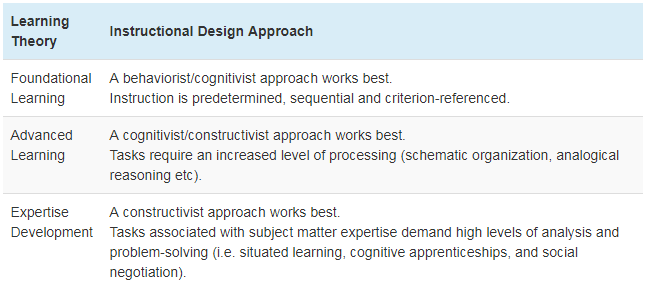Is Your Instructional Design Strategy Right For Your eLearning Project?
01 Aug

Table of Contents
ToggleImplementing instruction and collaborating with Subject Matters Experts aside, the early stages of planning and designing an effective learning experience are influenced greatly by the Instructional Design strategy employed.
What instructional design strategy should you use for your e-Learning project?
The role of the Instructional Designer is one of the most integral ones on an eLearning team. The Instructional Design strategy is majorly influenced by the requirements of the stakeholders, the resources available, the objective of the training program, and how it will be delivered to the learners.
These macro factors influence smaller, yet critical decisions for the design and development of the eLearning project.
What learning theory would serve the project’s needs best? What Instructional Design model is to be used? Is the ADDIE model for Instructional Design most suitable or does your team need to use something else? How should it be adapted to suit the project’s requirements?
What would be the timeframe for each iteration? How will the Instructional Design team collect feedback before, during, or after each iteration?
These are all aspects of the Instructional Design strategy. A lot of these are not just matters that concern the Instructional Designers, but also the project manager and other internal decision-makers.
Here we delve into the specifics for some of these aspects that can help an Instructional Design and eLearning team determine whether they have a solid Instructional Design strategy in place.
What Learning Theory Are You Using?
As laid out by Wikipedia, learning theories are
“Conceptual frameworks describing how knowledge is absorbed, processed, and retained during learning.”
This includes environmental factors, cognitive factors, as well as emotional factors.
In the context of eLearning and L&D, the main learning theories are behaviorism, cognitivism, and constructivism.
Behaviorism
This theory centers on the principle that behavior can be modified with external triggers to achieve the desired results like performance improvement or skill development. As the actions to modify behavior are repeated, behavioral patterns become more refined.
This is the reason that several educational programmes, especially practical and vocational courses, stress learners repeating tasks multiple times so that behavior can be modified.
One of the foremost applications of behaviorism was in the work of Ivan Pavlov, who carried out experiments with dogs to explain classical conditioning of behavior better.
Cognitivism
This theory is based on the principle that instruction should target the cognitive aspects of the brain such as memory, thinking ability, problem-solving, etc. It focuses more on the individual needs of the learner, rather than applying a general rule for all instruction.
Cognitive aspects in the brain work on a certain understanding of logic, spatial arrangements, and memory. If Instructional Designers can understand the relationships between various cognitive aspects, then it can give them valuable insight into how to customize eLearning courses for learners.
Constructivism
Constructivism works on the theory that every person has a different way of constructing mental maps or schemas in their brain based on past experiences and learnings.
The role of instruction and the instructor is to facilitate learning by enabling connections between the new concepts and past experiences. This model emphasizes the importance of the learner as the central cog in an Instructional Design approach.
So, what Instructional Design approach would work best for you?
To establish this, certain factors need to be determined:
- The process for delivery of learning
- The surrounding factors of the learning environment
- The role of memory and other cognitive aspects in learning
- Method of knowledge transfer
Here is a useful chart that suggests what learning theory would generally work better in different scenarios.
 Source: Understanding Instructional Design
Source: Understanding Instructional Design
What Instructional Design Model Are You Using?
Apart from the learning theory, which gives Instructional Designers a base to work on, Instructional Design models provide a structure for Instructional Designers as well as the project.
Instructional Design models came about during military research into how people and technology could be integrated into system development. Most Instructional Design models can be loosely divided into the stages of planning, design, development, testing, and implementation & review.
Some of the popular Instructional Design models are:
ADDIE
The ADDIE model for Instructional Design consists of 5 stages. Analysis, Design, Development, Implementation, and Evaluation.
At the Analysis stage, the scope, cost, and timeline of the project are identified. The learners’ needs and learning objectives need to be established. As do the factors and constraints in the learning environment. The Design stage establishes the flow and structure of the course. At this stage, objectives for each learning module need to be determined and an evaluation system to judge if the course has helped the learners. During the development stage, the actual delivery method and learning material are prepared. This material is distributed in the Implementation stage. At the Evaluation stage, feedback is collected from stakeholders and learners to review if the project has indeed met its intended goals or not.
Successive Approximation Model (SAM)
Successive Approximation Model focuses on “repeated small steps, rather than perfectly executed giant steps”. Instead of a linear approach, like in the conventional ADDIE model for Instructional Design, SAM is more agile in nature.
There are 3 phases in this model. There is the preparation phase, where information and data are gathered. “Savvy start” is an important part of the successive approximation model. All stakeholders come together for an initial brainstorming session to understand requirements.
After the preparation phase comes to the iterative design phase, where the ideas brainstormed in the first stage are prototyped rapidly so that they can be validated by internal and external stakeholders. Based on feedback on the prototypes, the iterative design phase rotates quickly through the design, prototype, and review phases.
This is followed by the iterative development stage. The prototypes that come through after the iterative design phase, and after validation, go through a further refinement of development, implementation, and evaluation. The learning material can be put through an alpha and beta phase before being released at scale for all learners.
The advantage with each of these phases is that as requirements change, so can the specifics of the process, because these are iterative steps and not overly rigid guidelines that come have been put down from the start.
ASSURE Model, Dick And Carey, And More
There are other similar models like the ASSURE model — Analyze learners, State standards and objectives, Select strategy, media, and material, Utilize media and material, Require learner participation, and Evaluate and revise. It is especially useful for integrating technology and media into the course structure.
There is the Dick and Carey model which lays down ten steps for designing instructional courses. These include:
- Assessing instructional goals
- Doing instructional analysis
- Defining prerequisites for the learners
- Learning objectives
- Creating assessments for the learners
- Developing a strategy for delivery
- Developing instructional materials
- Formative evaluation
- Summative evaluation
- Revising the course
There are even more Instructional Design models to suit a variety of needs based on project requirements.
Each Instructional Design model has its pros and cons. The main question comes down to what is the best Instructional Design model for your course. Considering certain elements can help get to the answer. These are:
- Understanding course designers cognition
- Making learning objectives a reference point
- Evaluating the aspects of possible Instructional Design models
- Getting feedback from different stakeholders on the Instructional Design team
- Determining needs and preferences of the learners
- Getting learning resources in advance
- Gauging future needs of the course and how that could impact delivery and structure. Of course, there is no one size that fits all the approaches for everyone. Reading practical examples from eLearning experts discussing various ways in which they have adapted the theoretical processes to suit their needs is helpful.
Conclusion
For any Instructional Design strategy that Instructional Designers are implementing, Robert Gagné’s Nine Events of Instruction provides a useful checklist of things to cover. The nine steps of instruction consist of:
- Gaining learner’s attention. This can be done through external stimuli and by posing interesting questions.
- Informing learners of the objectives. This helps set standards and goals for them to understand the endpoint of what it is they are trying to achieve.
- Stimulate recall of prior learning. Connecting new concepts to previous experiences and learnings is something we discussed in constructivism, and it is an incredibly effective way of bridging knowledge gaps.
- Present learning material.
- Provide learning guidance. This can be in the form of case studies, workshops, examples, etc.
- Eliciting performance in the form of tasks and learning activities.
- Provide feedback to motivate, correct and analyze learner performance.
- Assess performance.
- Enhance retention and impact of learning material.
Originally published at elearningindustry.com on May 18, 2018.
Improve your instructional design process with zipBoard
Instructional designers, project managers, clients and subject matter experts on e-Learning teams have been able to boost productivity and tune out the noise during collaboration so that they can deliver more projects.
Get DemoSign up FREERelated Post
Recent Posts
- Best Practices for Efficient Document Reviews and Collaboration December 18, 2025
- MEP Document Management: How to Streamline Reviews & Avoid Rework October 3, 2025
- What Is Online Proofing Software? And Why Content Review Breaks Without It July 11, 2025
- How Laerdal Medical Cut eLearning Review Time by 50% with zipBoard’s Visual Review Tool July 9, 2025
- Why Your Team Needs a Content Feedback System (Not Just Comments in Docs) May 28, 2025
©️ Copyright 2025 zipBoard Tech. All rights reserved.


